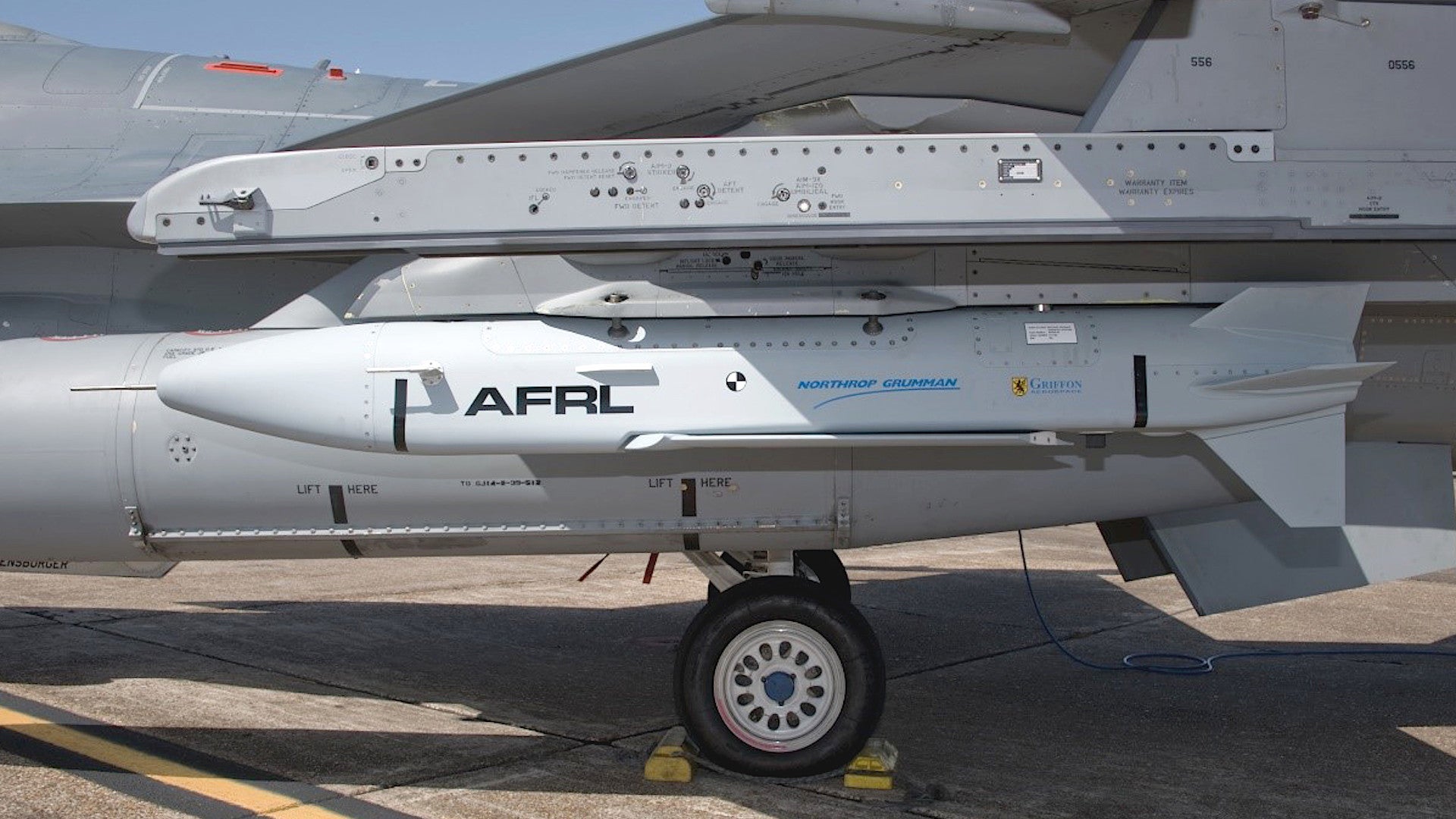The U.S. Air Force says it has completed a round of tests of a first-of-its-kind small, low-cost turbojet engine. The experiments were part of a program called Gray Wolf, which has focused heavily on the demonstration of technologies that could enable the development of cheaper cruise missiles. The engine could also power other future expendable air-launched systems or unmanned aircraft.
A TDI-J85 engine from Technical Directions Inc. (TDI), a division of drone maker Kratos, powered an expendable test article from Northrop Grumman during the test flights. The Air Force Research Laboratory (AFRL), which is responsible for the Gray Wolf effort, released a picture of an F-16 Viper fighter carrying the flight vehicle, which also bears the logo of Griffon Aerospace, along with its announcement on Mar. 19, 2020. AFRL first revealed Gray Wolf in 2017 and hired both Northrop Grumman and Lockheed Martin to supply testbed systems for the program in December of that year.
“The success of this test greatly increases our confidence in the performance of the engine and weapon systems as a whole,” U.S. Air Force Colonel Garry Haase, the head of AFRL’s Munitions Directorate, abbreviated AFRL/RW, said in a statement. “Developing the TDI-J85 engine in parallel to the cruise missile has proved challenging, but the collaborative partnership between AFRL, TDI, and Northrop Grumman has been outstanding.”

The TDI-J85 is 200-pound-thrust-class turbojet that weighs just 28 pounds. For comparison, the Williams F107 turbofan engine, which powers the AGM-86B Air-Launched Cruise Missile (ALCM) and variants of the Tomahawk Land Attack Cruise Missile, is in the 600-pound-thrust-class and weighs around 67 pounds.


“The TDI-J85 engine underwent a successful flight test campaign culminating in multiple inflight engine starts and operation at high altitude. The engine met performance expectations for thrust and surpassed fuel efficiency expectations,” AFRL news release said. “The engines tested accumulated sufficient inflight operating time, building confidence in the design durability.”
“The engine design focused on affordability and manufacturability, which enables increased production. Test results proved the engine capability,” it continued. “It is the first engine in its class and price point to successfully operate at altitude.”
AFRL did not give a unit price for the TDI-J85. As of 2014, each F107 was around $190,000.

TDI has been working on small jet engine technology, including for cruise missiles, since the 1980s. In 2013, it received almost $1.5 million from the Air Force for work specifically on “Low-Cost Propulsion System for Smart Munitions.” That contract ran through 2016, the year before the Gray Wolf program, which you can read about in more detail in this past War Zone story, began.
Low-cost, fuel-efficient engines have been a core focus of the program, primarily to help drive the overall cost of individual air-launched cruise missiles. In its most recent budget request for the 2021 Fiscal Year, the Air Force said that the average unit price across its purchases of both AGM-158A Joint Air-to-Surface Standoff Missile (JASSM) and AGM-158B JASSM-Extended Range (JASSM-ER) was approximately $1.266 million.

Needless to say, this kind of unit price makes traditional large scale cruise missile attacks an especially expensive proposition. The Air Force’s plans to network such munitions together in the future to act together in swarms requires the ability to launch even greater numbers of weapons all at once or in coordinated waves for maximum effect.
Beyond simply helping to reduce costs, improved fuel efficiency could also translate into greater range for weapons without having to increase the total amount of fuel they carry, something that could be invaluable in the future as the range of hostile air defense threats continues to increase. With an engine such as the TDI-J85, the fuel load could also be reduced to make room for larger warheads or other payloads, without sacrificing existing range.
At present, the Air Force says it is aiming to demonstrate an experimental low-cost cruise missile design that can “cruise for distances greater than 250 nautical miles.” This is roughly equivalent to the JASSM’s range, but significantly shorter than that of the JASSM-ER or future AGM-158D JASSM-Extreme Range (JASSM-XR), as well as of the AGM-86B ALCM and Tomahawk.
The improved engines also wouldn’t be limited to powering air-launched cruise missiles, either. Engines such as the TDI-J85 could help propel a new generation of other expendable systems, including decoys, as well as unmanned aircraft.
The Air Force’s future plans for the Gray Wolf program are not entirely clear. In June 2019, the service announced that it was canceling additional phases it had planned to carry out and would be transitioning work on networked swarming munitions to a different project, dubbed Golden Horde, which you can read about more in this past War Zone piece.

Even if Gray Wolf does wrap up soon, it’s very likely that work on the potentially game-changing TDI-J85 will continue as part of other efforts. As noted, TDI has already been working on cost-effective and fuel-efficient engines, including for cruise missiles, under contract from the U.S. military for decades now.
No matter what happens, the Air Force has clearly made important progress toward developing potentially game-changing low-cost cruise missiles, achievements that will likely impact the development of other systems in the future.
Contact the author: joe@thedrive.com
